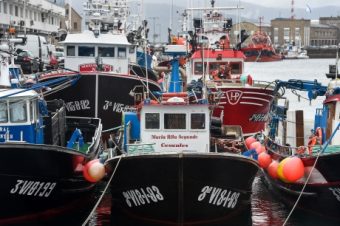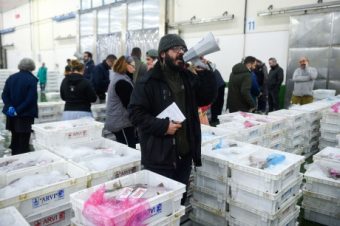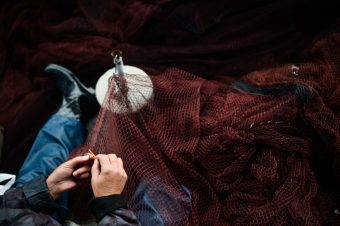On almost any given day, at four-thirty in the morning, while most people are still sleeping, Europe’s biggest fishing port in Vigo, Spain is in full swing.

In normal times of operation, shouts ring out from the multitude of workers offloading containers of fish from ships docked at the landing site. They cart the broad variety of fish to a series of on-site processing rooms, where containers are stacked high. Skilled workers wield sharp knives at their workstations, where they expertly cut and prepare fish filets at record speed.
In the port halls, traceability labels with bar codes are added to each carton, clearly indicating the fish species, method of catch, and the FAO fishing zone from which it was harvested.
And, despite the darkness of night that casts its silence on this Galician coastal city, the grand halls of the port are filled to the brim and transformed into raucous spaces as competing auctioneers shout into their megaphones. They sing out prices in Spanish and Galician, attempting to entice customers into purchasing the fish stacked high in cartons around them. Their words are lost in the cacophony of bids that echo throughout the halls as crowds weave their way around the containers loaded with the bounties of the sea.
“The city of Vigo lives for its port,” according to Corina Porro, Vigo Delegate, Regional Government of Galicia, Spain. “Nighttime in Vigo includes working in the fish markets… This is the life of Vigo, our city.”
But these are not normal times.
In this new era of COVID-19 and the need for physical distancing, what happens to this hive of daily activity – the sights, smells, sounds and relentless movement – that is Europe’s largest fishing port?
Spain is one of the countries that has been most affected by the COVID-19 epidemic. It is also the country that consumes the largest amounts of fish and seafood in Europe, at around 42.8 kilograms per capita annually.

Keeping operations going
To ensure food reaches consumers, who are largely quarantined in their homes, supply chains must be maintained. Therefore, Vigo’s port continues to be operational, while simultaneously protecting the health and welfare of its workers all along the fisheries value chain. But this is no small feat.
“We have adopted, inasmuch as possible, the teleworking technology… in this way, we haven’t reduced staff, even if we have drastically reduced presence at the port premises. This is working reasonably well,” describes Enrique López-Veiga, Vigo Port Authority President. “There are very few workers present on the premises, so interpersonal distance requirements are met. Hygiene and constant cleaning are also a must [to be in line with new regulations].”
“The biggest challenges are to keep the Port of Vigo fully operational, especially when it comes to the fresh fish market. This is a daily operation, since frozen fish depends less on the day-to-day marketing and storage.”
Consumers in a crisis
Vigo’s struggles are not unique. These effects are being felt throughout fisheries value chains around the world. Fish provide more than 20 percent of the average per capita animal protein intake for 3 billion people, more than 50 percent in some less developed countries, and it is one of the most traded food commodities globally. Thus, the impact on the livelihoods of fisher communities, food security, nutrition and trade, especially in those countries that rely heavily on the fishing sector, is expected to be significant.
In addition to the challenges in the fisheries sector, the crisis has also affected the way consumers behave and what they buy. This is especially noticeable in a country like Spain with high levels of fish consumption.
“Because of the restrictions on movement, customers are no longer going to the markets and that decreases the demand on fresh fish, but especially on the high price products like shellfish and crustaceans. Those are products that consumers abandon quickly in a crisis,” explains López-Veiga. “This results in a general decrease of prices paid to producers, especially to the artisanal and small-scale fisheries sector.”
“We are pleased to see Vigo’s impressive efforts to keep its fisheries supply chains operational in these difficult times,” says Audun Lem, Deputy-Director of FAO Fisheries and Aquaculture Department. “Fisheries value chains are extremely long, complex and international, even in ordinary times. We appreciate the extraordinary efforts undertaken around the world during the current crisis to keep supply chains open and to ensure that healthy fish and seafood products, a key component of nutritious diets, are reaching the end consumer.”

Sustainable and supportive
A big proponent of small-scale fisheries, Vigo has, in recent years, been active in innovating and promoting its role as a “Blue Port”, focusing on conservation of the marine environment, while simultaneously improving the socioeconomic and labour conditions of those whose livelihoods depend on the port and its activities.
Vigo has been partnering with FAO and other ports around the world to create a network of sustainable Blue Ports, to support each other in exchanges of information and international training in areas such as fisheries inspections.
In the time of COVID-19, this network and collaboration of ports provides the added benefit of sharing experiences in responding to the crisis and, eventually, in bouncing back once the crisis has been resolved.
According to López-Veiga, the port is already taking stock of lessons learned during this crisis: “We think that the path the Vigo port has taken, on Transparency, Traceability, Quality and Sustainability, which implies a high degree of informatization and control of the systems – has facilitated the implementation of the extraordinary measures we are now facing. This reaffirms our belief that we must keep advancing along this line in the future.”
Europe’s largest fishing port will once again buzz with ceaseless activity, sounds and movement, and Vigo and its network of Blue Ports will help build a stronger and more resilient fisheries value chains around the globe.
Amidst a crisis of this magnitude, the problems often appear insurmountable, and solidarity and a sense of community can be crucial to overcoming the challenges in guaranteeing that the food chain continues to operate. According to López-Veiga, community support has been vital to the port’s ability to carry out its operations in these difficult weeks. “As times goes by, stakeholders are increasingly aware of the need for self-discipline and solidarity. In that sense, we in Vigo may be proud about how things are developing in the port community, which reflects what is happening throughout the entire country.”
FAO is helping support countries through this COVID-19 pandemic. By providing policy recommendations on a variety of areas related to food and agriculture and offering a portal to share national strategies and policies, FAO is working to ensure that the impacts of COVID-19 on the food and agriculture sectors does not fall solely or irrevocably on the poor and food insecure. FAO is making sure these voices are heard and is standing beside countries in their responses during this difficult time.
Source: FAO



